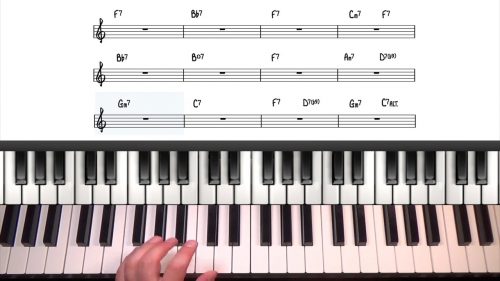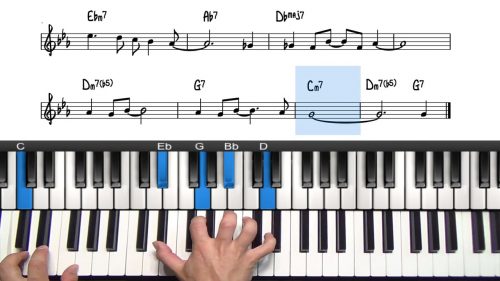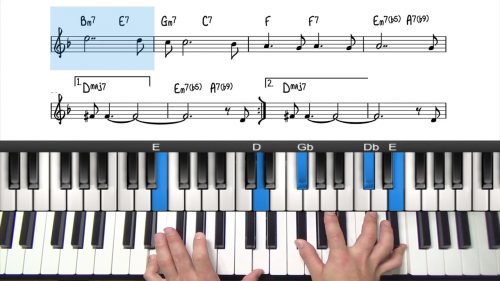How To Play Like Wynton Kelly
In this lesson we will take a look at one of my favorite pianists in jazz, Wynton Kelly. He is known for his very distinct eighth notes and bluesy but at the same time very modern approach. He is also considered to be one of the greatest accompanists, his comping is definitely worth studying.
The Transcription
For this lesson we will explore the first solo on a blues called Pfrancing, from the 1961 Miles Davis record Someday My Prince Will Come. This solo shows his bluesy simplicity as well some more modern choices and it is also an excellent example of his eight notes and time feel. Learn this solo by heart and play it with the record as close to the original as possible, it will help you to improve your time feel and groove.
Wynton Kelly Transcription Assignments
Be sure to check out the Wynton Kelly Transcription Exercises in the PianoGroove Community Area.
Career Synopsis
Wynton Kelly was born on December 2nd, 1931 in Brooklyn, New York, and died April 12th, 1971 in Toronto, Canada. Early in his career he worked with Dinah Washington and Dizzy Gillespie and, after 2 years in the army, he worked with many other notable bandleaders including Julian “Cannonball” Adderley, John Coltrane, Roland Kirk, Wes Montgomery and Sonny Rollins, as well as vocalists Betty Carter, Billie Holiday, and Abbey Lincoln.
Work With Miles Davis
In 1959 he joined Miles Davis’ band. This band was between the two main quintets Miles had, working only for short period of time, but for my opinion this band and the rhythm section is one of the most important and ground breaking bands in the history of jazz. They recorded several great albums and you can also hear Wynton Kelly on the famous Miles record Kind Of Blue.
The Wynton Kelly Trio
After leaving Miles, Kelly continued to work with the same trio that he had played with in Miles’ band: Paul Chambers on bass and Jimmy Cobb on drums. He also continued working as a sideman, recording numerous great albums with different leaders, for example Hank Mobley, Blue Mitchell, Joe Henderson and Wes Montgomery.
Notable Recordings
As a leader:
- Kelly at Midnight
- Kelly Blue
- Wynton!
- Piano
As a sideman:
- Hank Mobley – Soul Station
- Miles Davis – Someday My Prince Will Come
- Joe Henderson – Four
- Wes Montgomery – Smokin At The Half Note
- Johnny Griffin – Introducing Johnny Griffin
Practice Tips
-
Check out the Wynton Kelly Transcription Exercises in the PianoGroove Community Area.
-
Kelly's time feel is very distinctive: try to match it by playing this transcription along with the recording.
-
This transcription shows Kelly's masterful use of the blues scale. If you're not familiar with this commonly used scale check out the related lesson above.
-
This solo contains a lot of great bebop-style material. Choose a few phrases to learn and apply them while improvising over other blues or bebop tunes.







Wow! What a generous offering to create theses lesson series on some of the masters–and all the transcriptions! Thank you. This is completely engaging.
Thank you Lonnie, I’m glad to hear you liked the course!
Let me know if you have any questions,
All the best,
-Tuomo
Ok Tuomo, i’m going to risk being greedy and ask for you to put on your future list of student requests the transcription of the famous solo of Wynton Kelly on Freedie Freeloader on Kind of Blue. You have every right to holler and say NO! Because i haven’t even put my hands on the piano to learn your current lesson…–which i promise I will. Thanks again for this great series.
I’ll keep that in mind!
That’s actually one of my favorite solos as well,
keep up the good work :)
-Tuomo
What do the crossed notes mean in the transcription? I can’t hear them in the recording
Hi Kester,
Crossed notes in transcriptions are “ghost notes”.
A ghost note is a musical note with a rhythmic value, but no discernible pitch when played.
Ghost notes can be purposely de-emphasised by the performer, often nearly to the point of silence, but the rhythmic value of the note still remains.
Hope that helps and any further questions let me know.
Cheers,
Hayden
Such a very interesting and beautiful piece! Thanks very much for the wonderful lesson! I’ve always been curious about this style of jazz – so I would love to challenge myself to tackle this course series and add it to my Jazz learning goals! :D Your explanation and demonstration was very helpful. Fully enjoyed the lesson!
Sorry forgot to ask :) by any chance, is there an audio recording of this wonderful song please? Thank you so much in advance. Take care.
Hi Maria 👋🏻
Glad you enjoyed the lessons.
You can find the tune “Phrancing” here on YouTube:
and you can find it here on Spotify: open.spotify.com/track/03nhziAroKGWbGvl07DF6G?si=L-IycaEySc-hr10ZPSYi7w
Enjoy listening!
Cheers,
Hayden
Can 7 explain the use of e triad over b flat chords
Why does it work
Hi Mike,
Good question, an Eb Triad over a Bb7 chord create a suspended sound, in particular a sus13 sound.
The notes of the triad in relation to Bb7:
– Eb is the suspended 4th of Bb7
– G is the 13th of Bb7
– Bb is the root of Bb7
The triad built of the 4th of the chord is commonly used in blues to create suspense and tension.
Check out our lessons on sus chords for the theory information: pianogroove.com/jazz-piano-lessons/how-to-play-sus-chords/
You might also like to check out this seminar where the teacher demonstrates using the IV of each chord as a fill: pianogroove.com/live-seminars/slow-blues-workshop/
I hope that helps.
Cheers,
Hayden